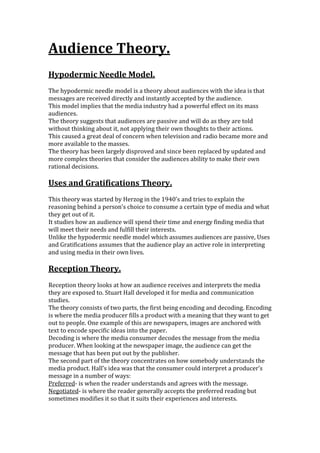
Audience theory task 3
- 1. Audience Theory. Hypodermic Needle Model. The hypodermic needle model is a theory about audiences with the idea is that messages are received directly and instantly accepted by the audience. This model implies that the media industry had a powerful effect on its mass audiences. The theory suggests that audiences are passive and will do as they are told without thinking about it, not applying their own thoughts to their actions. This caused a great deal of concern when television and radio became more and more available to the masses. The theory has been largely disproved and since been replaced by updated and more complex theories that consider the audiences ability to make their own rational decisions. Uses and Gratifications Theory. This theory was started by Herzog in the 1940’s and tries to explain the reasoning behind a person’s choice to consume a certain type of media and what they get out of it. It studies how an audience will spend their time and energy finding media that will meet their needs and fulfill their interests. Unlike the hypodermic needle model which assumes audiences are passive, Uses and Gratifications assumes that the audience play an active role in interpreting and using media in their own lives. Reception Theory. Reception theory looks at how an audience receives and interprets the media they are exposed to. Stuart Hall developed it for media and communication studies. The theory consists of two parts, the first being encoding and decoding. Encoding is where the media producer fills a product with a meaning that they want to get out to people. One example of this are newspapers, images are anchored with text to encode specific ideas into the paper. Decoding is where the media consumer decodes the message from the media producer. When looking at the newspaper image, the audience can get the message that has been put out by the publisher. The second part of the theory concentrates on how somebody understands the media product. Hall’s idea was that the consumer could interpret a producer’s message in a number of ways: Preferred- is when the reader understands and agrees with the message. Negotiated- is where the reader generally accepts the preferred reading but sometimes modifies it so that it suits their experiences and interests.
- 2. Oppositional- is where the reader understands the preferred reading but rejects this notion and has an alternative, opposing view. The way the audience reads into an idea depends on their own values, experiences and background. People will apply their own ideas to the message in the media product, so people with similar thoughts to the people who made the product are likely to have a similar reading, these like-minded people can be seen as the target audience. People with opposing ideas are very different and are more likely to disagree with the messages. Real World Application. Hypodermic Needle Model. An advert for Tesco tells viewers to go out immediately and buy coca cola while it is on offer. If the Hypodermic Needle Model were correct this would mean that the audience would obey the advertisement and immediately go to Tesco and buy the drink. Uses and Gratifications Theory. An advert for Tesco tells viewers to go out immediately and buy coca cola while it is still on offer. If the uses and gratifications model is correct the audience member would draw on past experiences and other factors for example; do they like coca cola, do they have the money to go to the shop, isn’t their anything they would rather do. Having considered these factors the viewer would make a conscious and active decision. Reception Theory. A newspaper story features an image showing a protester being arrested with the caption “peaceful protest at the house of commons turned into a riot by the London police service”. Here the media producer has encoded a message into the story trying to state that protesters were unfairly and harshly treated. The consumer decodes the message; if a preferred reading is achieved then the audience will understand the encoded opinion and agree with it. If a negotiated reading is achieved the consumer will understand and partly agree with the media producers opinion, but may also add their own opinions and thoughts such as “the police may have been forced to act in this way” etc. If the reader comes to an oppositional reading then they will disagree with the encoded opinion and believe that the decision to use force by the police was correct and the protesters were in the wrong.
